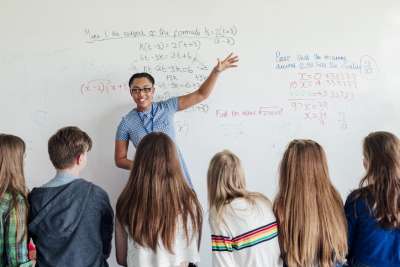Learn how to effectively use fraction strips, spinners, counters, and more
Manipulatives are physical objects that are used as teaching tools to engage students in the hands-on learning of mathematics. They can be used to introduce, practice, or remediate a concept. Use this resource to help your students learn how to use manipulatives successfully.Looking for more manipulatives like fraction strips? Find them in our math resources center.
Using Manipulatives
What Is It?
Manipulatives are physical objects that are used as teaching tools to engage students in the hands-on learning of mathematics. They can be used to introduce, practice, or remediate a concept. A manipulative may be as simple as grains of rice or as sophisticated as a model of our solar system. They may be store-bought, brought from home, or teacher- or student-made. They can be used in all areas of math instruction-teaching number and operations, algebra, geometry, measurement, and so on-and across all grade levels.
The following are a few manipulatives that might be used at the elementary level.
Number and Operations
Counters can be used to teach one-to-one correspondence, ordinal numbers, and basic addition and subtraction.
Two-sided counters can be used to model one-to-one correspondence, addition and subtraction, or skip-count.
Place-value mats can be used to show each digit's place value when using base-10 blocks.
Base-10 blocks can be used to model the variety of ways a number can be represented, and to model regrouping when adding, subtracting, multiplying, and dividing.
Money, in coins or bills, can be used to count, skip-count, or model regrouping when adding or subtracting.
Fraction strips can be used to show equivalent fractions, to add fractions, to subtract fractions, or to find common denominators.
Algebra
Pattern blocks can be used to create, find, or extend patterns.
Attribute blocks can be used to sort and classify according to shape, color, size, or other attributes.
Pan balances or scales can be used with objects or weights to show equivalent values.
Geometry
Geoboards can be used to identify simple geometric shapes and describe their properties and to develop spatial sense.
Geometric-solid models can be used to teach nets or spatial reasoning.
Measurement
Standard and non-standard rulers and measuring cups can be used to represent length or volume.
Tiles can be used to find the area or the perimeter of an object.
Data Analysis and Probability
Spinners can be used to find the experimental probability of landing on a designated area.
Number cubes or dice can be used to find the experimental probability of rolling a certain number or a combination of numbers.
Why Is It Important?
According to learning theory based on psychologist Jean Piaget's research, children are active learners who master concepts by progressing through three levels of knowledge--concrete, pictorial, and abstract. The use of manipulatives enables students to explore concepts at the first, or concrete, level of understanding. When students manipulate objects, they are taking the necessary first steps toward building understanding and internalizing math processes and procedures. For example, when learning to add fractions, students can use fraction strips to represent each addend. They then add the fractional parts to find the sum. After practicing with these, they can progress to finding sums for problems on paper, represented by pictures with corresponding fraction numerals (pictorial level). Over time, they will devise strategies and apply algorithms so they can find sums when given only the addition expression (abstract level).
For a learner to understand and handle a concept a the abstract or symbolic level successfully, he or she must first understand the concept at the other two levels, in the order given-concrete then pictorial. Using concrete manipulatives is the first step to using mental images and models. When students demonstrate understanding with the concept at this physical, or concrete, level then they are ready to move to the next level, where they can apply their knowledge using representations of the objects in place of the objects themselves.
Young children often solve addition and subtraction problems by counting concrete objects, beginning with their fingers. They go on to use concrete objects such as base-ten blocks and counters to develop more sophisticated problem-solving strategies based on what they know about counting (Siegler 1996).
Concrete models can help students represent numbers and develop number sense; they can also help bring meaning to written symbols and can be useful in building place-value concepts. You should try to "get inside students' heads" as they work with concrete materials by asking questions that elicit their thinking and reasoning. In this way, you can get a better sense of what students know and don't know, along with identifying misconceptions, thereby developing a basis for intervention strategies. You should also choose interesting tasks using manipulatives (such as an abacus) that engage students in mathematical thinking and reasoning, which builds their understanding of numbers as well as relationships among numbers (NCTM 2000).
In fact, research shows that using manipulatives can contribute to the development of well-grounded, interconnected understandings of mathematical ideas. Students can more easily remember what they did and explain what they were thinking when they used manipulatives to solve a problem (Stein 2001).













